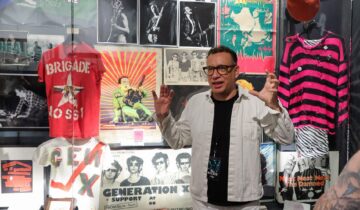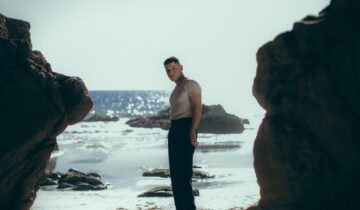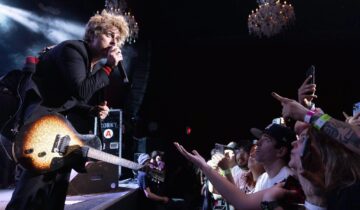 For RADIO SILENCE MAGAZINE: I listened to a lot of Van Halen in 1986, when I was thirteen, living with my family in Iowa. I had copies of Diver Down, Van Halen I and II, Women and Children First, and 1984, and my cassette tapes looked like they had been to a battlefield and back. I rewound the beginning of “Hot for Teacher” over and over to hear exactly what drummer Alex Van Halen was doing with his sticks. I thought Eddie Van Halen’s guitar fireworks on “Eruption” should be required listening for all humans.
For RADIO SILENCE MAGAZINE: I listened to a lot of Van Halen in 1986, when I was thirteen, living with my family in Iowa. I had copies of Diver Down, Van Halen I and II, Women and Children First, and 1984, and my cassette tapes looked like they had been to a battlefield and back. I rewound the beginning of “Hot for Teacher” over and over to hear exactly what drummer Alex Van Halen was doing with his sticks. I thought Eddie Van Halen’s guitar fireworks on “Eruption” should be required listening for all humans.
Alex Van Halen’s massive gong and artillery of rototoms amazed me. I mimicked his drumming with a pair of sticks on pillows and Tupperware. I had no idea how or why the guys in the band were “Runnin’ With the Devil,” but I was running right along with them, wherever they were going. The zit-faced older boys in my neighborhood with black-light posters on their bedroom walls listened to the same songs. They walked around in black jeans and T-shirts with a Van Halen attitude that I did not quite possess but wanted to.
Van Halen was a shark dominating a large sea of rock and metal, and I dove right in. I had no clue what “Round and Round” was about, but I sang along loudly with Stephen Pearcy and the rest of Ratt with my door shut and windows open. I played air guitar and pumped my fist to Mötley Crüe’s “Shout at the Devil” like it was my life’s mantra. My stepfather, a Congregational Church minister, was concerned. He began screening the lyrics of albums like “Lick It Up” from Kiss before I was granted permission to listen.
These bands and their music were “bad,” and I liked it. I was not bad in any way, shape, or form, but I became just a little bit tougher by listening.
And then, unexpectedly, my Van Halen universe collapsed. It happened swiftly, with no guilt or remorse, in 1987, as I entered eighth grade, when a friend handed me Run-DMC’s third album, Raising Hell. I was captivated by the album cover: The two rappers wore black leather jackets, black fedoras, and white Adidas sneakers. They had serious looks on their faces. Bad? Tough? Hell yes. Then I put in the cassette.
My sonic universe was flipped on its head. The music was raw like Van Halen and other rock bands, but Run-DMC had something else that I could not put my finger on at the time but now can—authenticity. They didn’t have David Lee Roth’s vocal acrobatics, and they didn’t play instruments, but they talked about real things against a backdrop of rock guitar licks, funky drumming, album scratching, and samples of other artists’ songs.
My best friends and I foolishly mimicked our new idols: We wore unlaced sneakers with parachute pants, brand-name hooded athletic jackets, and baseball hats flipped way up. We postured and posed like Run-DMC in an effort to capture some tiny piece of what they had or what they were. Middle school girls gathered to hear us recite the lyrics to “Son of Byford” and beatbox at eighth-grade dances held in the basement of a local Methodist church. We formed our own rap group—the Short Boys—and recorded beats and rhymes on tapes in my bedroom. We had fun. We were young, middle-class, white boys in Iowa trying to emulate adult black artists from Queens whom we knew very little about. It was a naïve combination of cultural appropriation, voyeurism, and straight-up dumb-assery.
But their music drew us in because it was different from anything we had heard or experienced. It had humor and soul with a sense of urgency. It commanded our attention, with lyrics backed by heavy beats. It had a heaping supply of confidence, swagger, and truth. They didn’t just speak words, they shot them out with power. Van Halen may have run with the devil, but DMC, in “Raising Hell,” says he “cut the head off the devil and I throw it at you.” Even the nursery rhyme–inspired “Peter Piper” was laced with heavy bragging and sexuality. Their earlier material from 1984, which we also listened to, had aggressive commentary on unemployment, poverty, and war. Van Halen was theater, but Run-DMC was real life.
The record labels—heavily marketing to my friends and me—were eager to promote “rap rock” to the far reaches of American suburbia, and they succeeded. Raising Hell went triple platinum and helped bring hip-hop into the mainstream. The album was my gateway to Eric B. and Rakim, LL Cool J, the Beastie Boys, Whodini, UTFO, Public Enemy, and others. The sampled sounds found in those albums helped introduce me to funk, soul, blues, and jazz music. It was the beginning of my slow but growing awareness of issues around race, class, and gender.
Communities in our town were not entirely but largely segregated. In Jeff Chang’s book Can’t Stop Won’t Stop, rap music is described as offering a radical “voluntary desegregation plan” with vast social implications for American culture. On “Proud to Be Black,” the last track on Raising Hell, Run-DMC describes the accomplishments of famous African Americans like Martin Luther King Jr. and Jesse Owens, but they express frustration at being judged by the color of their skin. We were not exploring this dichotomy in school, but we could pop in the tape and perhaps gain some level of access and exposure to the ideas by listening.
Van Halen taught me to rock out. Run-DMC taught me that music isn’t for spectacle only: Hip-hop’s beats and rhymes could ignite discussion, thought, and debate and get a party started all at once.
Art/illustration by Ron Liberti



